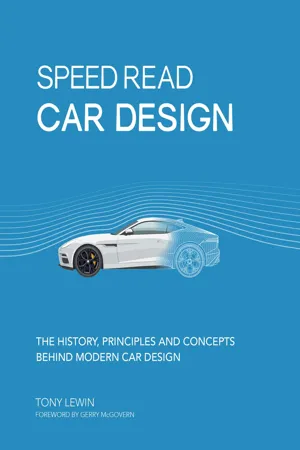THE BIRTH OF CAR DESIGN
Introduction
Evolution of the Species
The Golden Age of Car Design
Power to the People
Harley Earl
The Emergence of Style
Glossary
INTRODUCTION
DESIGN—THE GREAT DIFFERENTIATOR
Design had little or no part to play when the very first automobiles sputtered to life. Even engineering—if it could be flattered with such a term—was in short supply as pioneer inventors improvized with available materials from the horse and cart era. Comfort and style were irrelevant: the priority that overwhelmed everything else was that the contraption would start and would not break down too frequently.
Fast forward twelve decades to today’s mass-produced models and the position could not be more different. Today, performance and complete reliability are taken for granted, and it is design that sets one model apart from another. The image the car projects—what it looks like, how it feels, and how its quality stacks up—all have become at least as important as its engineering and its responses on the road. In short, design has become the greatest differentiator and style is the new entry ticket to customers’ hearts. Cars, like clothing brands, have become industrialized, commoditized, and commercialized. They are close to becoming fashion impulses rather than measured technical choices.
All this has elevated car design—and by consequence, the car designer—to new heights of importance. Now both the architect and the guardian of the brand, the designer is the figurehead giving visual expression to its messages and its values.
But it was not always so. While some of the early proprietors cared little about the appearance of their products, others, especially as the 1920s morphed into the 1930s, became fierce in the protection of the visual message delivered by their models.
For every Henry Ford decreeing that all cars must be black and basic there was a Vincenzo Lancia or André Citroen blending engineering innovation with elegant style; while Charles Rolls and Henry Royce specified their palatial radiator grilles but left the aesthetic shaping of the bodywork to outside craftsmen, there was Ettore Bugatti who, in collaboration with his son Jean, produced complete machines of such exquisite beauty that they are still feted as works of art. Later, William Lyons’s intuitive instinct for style ensured that all Jaguars would share the same sense of lithe, sinuous elegance, and in the modern era companies such as Audi have built their reputation on meticulous attention to every aspect of design.
Though Jaguar’s Lyons era is separated from Audi by several decades, the two share the common thread of a powerful individual with a keen eye for style and a strong brand image. Today, corporate consensus may have replaced the proprietor’s decree, but the message is the same: quality design sells, and is essential to the building of a strong brand position. What is different now is that good design has become democratized: thanks to companies such as Renault, which was a pioneer in bringing in design at a strategic level, true style is accessible to all—not just the fortunate few.
THE BIRTH OF CAR DESIGN
EVOLUTION OF THE SPECIES
Crossovers, shooting brakes, four-door coupés, off-road convertibles: the list of body styles is endless and the variety of formats offered today is truly bewildering. But has this always been the case?
In the 1950s and 1960s, when sedans and station wagons ruled the roost, there was much less variety. This was for sound technical reasons as automakers were just getting to grips with building cars with unitary construction techniques that, initially, made it uneconomic to add further body styles. In the interwar period the selection of styles had been broader: when vehicles were built on a separate chassis, the upper body was not a structural element and it was easier to provide a range of options.
It is possible to trace the origins of almost any body style back to the formats that first began to develop in the early 1900s. Coachbuilders applied their horse-and-carriage styles to motorized chassis: saloons had full roof structures to keep passengers warm, while limousines and broughams left the chauffeur out in the cold. Landaus and phaetons could be opened up at the rear; coupés were simply cut-down versions. Sports cars evolved along a separate path: minimalist and much lower, they remained stark and functional until the aerodynamic 1936 BMW 328.
Greater orthodoxy ruled the postwar decades, with the two-seater sports car a highlight. The 1960s saw the rise of small cars as well as the first examples of a body type that would become dominant—the hatchback. In 1970 the Range Rover set the seeds for the sports utility craze of the late 1990s, which in turn led to the post-2010 crossover phenomenon as automakers merged SUV design cues with mass-production car platforms.
And as the 2020s draw near, further trends are becoming clear: electric cars of all shapes and sizes, the emergence of compact but tough-looking “urban” crossovers, and the polarization of the large-car sector into low-slung, sporty, four-door coupés and more versatile models incorporating design cues from crossovers. And then there is the expected arrival of dedicated zero-emission vehicles locked in to urban mobility programs—and that will be yet another new direction in design.


